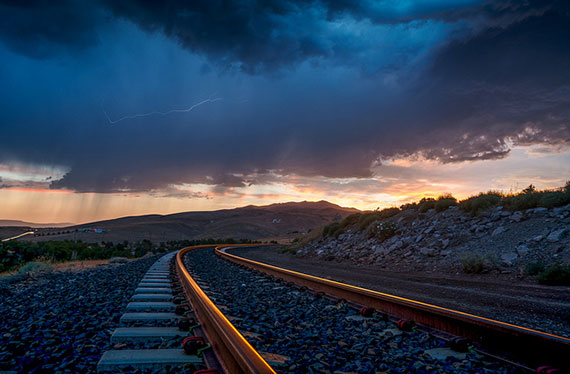We’ve all sat, staring out of our window and cursing at the rain poring down or the flat, grey sky that just happened to cloud over on few hours we’ve managed to set aside in our busy schedule to head out and shoot some photos. But all is not lost for the opportunistic and well prepared photographer.
Be Patient
After many rainfalls or storms, comes a spectacular burst of light. Often this light lasts only momentarily, but is worth waiting for. But you’re never going to catch it if you’re still staring out of that window. Part of making good photographs is being an opportunist. Weather reports are easily accessible through the internet, over the radio, and in newspapers, often with detailed information.
You might be able to find out if the cloud cover or storm is about to pass. If not, head out anyway. Yes, it might all be in vain and remain gray and unappealing until nightfall and be a complete waste of time, but what if it isn’t?
If you speak to, or read any book written by a successful landscape photographer, they will tell you stories about how they visited a place dozens of times and waited for hours before getting that one in a million shot. Have a look at that shot. Was it worth the time? Chances are it was. Imagine the satisfaction gained from someone looking at your photo and letting out a breathless “Wow!” Then you’ll be the one telling the stories. A simple way to think about it is that you get out what you put in.
Be prepared
Have you done any research on your subject? Have you visited your location at this time of day before? Do you have a list, or at least a mental outline, of the photos you want? Have you considered the equipment you might need to take? Answering these questions will take you a long way to being able to seize the moment when it does eventually arrive.

Photo by Beau Rogers; ISO 100, f.8.0, 1.6-second exposure.
Instead of fumbling around trying to attach lenses, tripods, filters and any other gadgets that might be necessary, (and I do mean “might”), you will simply be able to step out of your car, or hiding place, gear in hand, and calmly collect the images you’ve been imagining.
A little foresight in taking care of these things beforehand allows you to focus completely on taking photos once in the field. As with anything else, if you can concentrate completely, you’ll likely do a better job.
What’s your purpose?
Think about what you are actually trying to achieve with these pictures. Do you even need blue skies? Many a moody, muted landscape has been created using the worst weather conditions. If you have an interest in shooting black and white images, you could be in for a real treat. Many subjects, such as outdoor portraits, can work better in overcast conditions, enabling you to pick up the lines in someone’s face and add character to the portrait without having to worry about your subject squinting their eyes from the sun or dark shadows appearing over half of their face.
Most successful photography, like anything else, comes from having a clear goal and taking the steps necessary to achieve it. It also comes from working with the elements and planning for various possibilities. Open yourself up to new ideas and you will find that your photography improves markedly.
About the Author
Mark Eden is a freelance travel photographer and writer, and the founder and director of ExpansePhotography, a photographic services company offering fine art, limited edition prints as well as stock and assignment photography and publishing services. Mark can be contacted through the Expanse Photography website.
Like This Article?
Don't Miss The Next One!
Join over 100,000 photographers of all experience levels who receive our free photography tips and articles to stay current:








Amazing techniques! Thank you for sharing your technique to us. I will always follow all your tips!
@ Arnell.
They are not a secret.
For exposures – It really depends;
#1 what you are trying to achive.
#2 The light
#3 What gear (camera/lens/tripod etc) you have with you.
From personal experience I try to keep the native ISO as low as possible (to minimise noise)
The shutter speed fast enough so that camera or subject motion doesn’t become a problem.
The aperture around F8-F11 (for SLRs and F5.6) for a point & shoot.
Use your histogram as the lighting may be tricky
Some examples from my flickr stream
#1 Lightening during a storm well before sunrise
20 seconds @ F10 and ISO 400 f=24mm on a full frame camera (manual exposure).
#2 Mid winter approaching storm at 1055 am Hand held.
1/1250 (it could have been a lot lower along with the ISO) @ F8 and ISO 400 F=135mm on a 1.5 crop camera.
I don’t shoot a lot of storms and usually it will be just a filter to keep the water off the lens (although I do use filters when shooting other ‘scapes)
Great, bad weather is the only weather to go out in for a cool dramatic sky..
Wow, this is a great photo’s for sure! I love the city with powerfull sky! and your article is very helpful, thanks for sharing to us!